20 Years Later: The Lingering Health Effects of 9/11
Written by Karen Selby, RN • Edited By Walter Pacheco
Asbestos.com is the nation’s most trusted mesothelioma resource
The Mesothelioma Center at Asbestos.com has provided patients and their loved ones the most updated and reliable information on mesothelioma and asbestos exposure since 2006.
Our team of Patient Advocates includes a medical doctor, a registered nurse, health services administrators, veterans, VA-accredited Claims Agents, an oncology patient navigator and hospice care expert. Their combined expertise means we help any mesothelioma patient or loved one through every step of their cancer journey.
More than 30 contributors, including mesothelioma doctors, survivors, health care professionals and other experts, have peer-reviewed our website and written unique research-driven articles to ensure you get the highest-quality medical and health information.
About The Mesothelioma Center at Asbestos.com
- Assisting mesothelioma patients and their loved ones since 2006.
- Helps more than 50% of mesothelioma patients diagnosed annually in the U.S.
- A+ rating from the Better Business Bureau.
- 5-star reviewed mesothelioma and support organization.
Testimonials
My family has only the highest compliment for the assistance and support that we received from The Mesothelioma Center. This is a staff of compassionate and knowledgeable individuals who respect what your family is experiencing and who go the extra mile to make an unfortunate diagnosis less stressful. Information and assistance were provided by The Mesothelioma Center at no cost to our family.LashawnMesothelioma patient’s daughter
How to Cite Asbestos.com’s Article
APA
Selby, K. (2022, December 21). 20 Years Later: The Lingering Health Effects of 9/11. Asbestos.com. Retrieved April 18, 2024, from https://www.asbestos.com/featured-stories/9-11-lingering-health-effects/
MLA
Selby, Karen. "20 Years Later: The Lingering Health Effects of 9/11." Asbestos.com, 21 Dec 2022, https://www.asbestos.com/featured-stories/9-11-lingering-health-effects/.
Chicago
Selby, Karen. "20 Years Later: The Lingering Health Effects of 9/11." Asbestos.com. Last modified December 21, 2022. https://www.asbestos.com/featured-stories/9-11-lingering-health-effects/.
Two decades after foreign terrorists attacked Americans on U.S. soil, the impact of Sept. 11, 2001, is still being felt today. Hundreds of thousands of people remain at risk due to the trauma and exposure to toxic air following each attack. Carcinogens from building materials, gases and jet fuel laced the air around each crash site, with the most severe toxicity among the ruins of the World Trade Center towers in New York City.
An estimated 410,000 first responders, cleanup crews and survivors spent days and weeks breathing in air heavy with toxins from 400 tons of crushed concrete, glass and asbestos at Ground Zero. Exposure to contaminated air and toxic chemicals created a growing list of health concerns for many of the men and women who were there, with some illnesses such as mesothelioma taking approximately 20 years to develop.
To date, more people have now died from this toxic exposure than in the 9/11 attacks. Although 2,974 people lost their lives that day, 4,343 survivors and first responders have died in the years since, according to the World Trade Center Health Program.
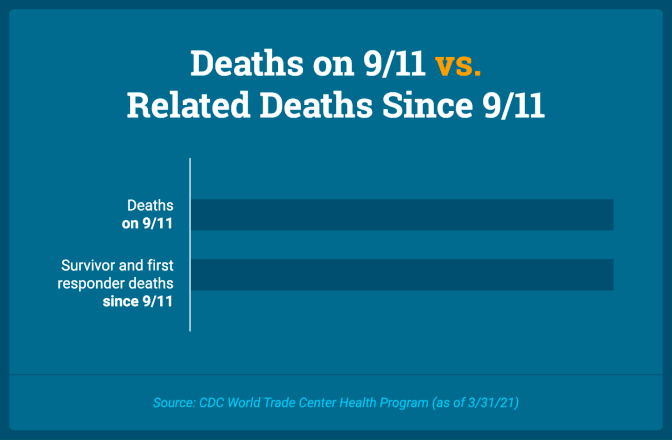
We conducted a survey to examine the public’s understanding of these issues and created a timeline of health effects resulting from 9/11 to illustrate the lingering damage caused by this historic tragedy. We will take a closer look at the impact on the heroic first responders and the years-long struggle to find consistent support for those who continue to suffer.
Do Americans Know About the Health Aftermath of 9/11?
A recent survey of 1,000 Americans by The Mesothelioma Center at Asbestos.com examined the public’s awareness of the ongoing health impacts of the 9/11 terrorist attacks.
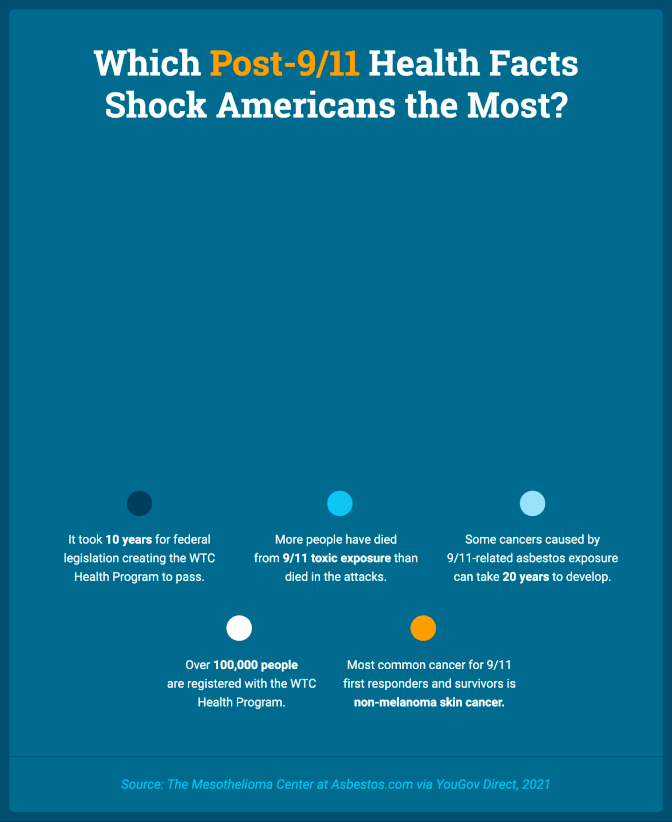
31% of Americans Shocked by Growing Death Count
Thirty-one percent of respondents revealed they were shocked by the growing death toll since 9/11, which has surpassed the total number of deaths from the attacks themselves. With the number of 9/11-related deaths continuing to rise, the 9/11 Memorial Glade at Ground Zero has added granite memorials to honor those lost in the years since the attacks.
Only 3% Can Identify Most Common Post-9/11 Medical Issues
When asked to estimate the most common medical issues plaguing survivors and first responders since 9/11, 31% of survey respondents guessed that PTSD was at the top of the list. Chronic respiratory disease (29%) and cancer (26%) were the next most common choices. While each of those conditions are certified and recognized by the Centers for Disease Control and Prevention’s World Trade Center Health Program, they are not the most common. Very few survey respondents selected the conditions that actually top the list, with only 2% choosing inflamed sinuses and 1% selecting GERD.
Number of First Responders’ Health Issues Significantly Underestimated
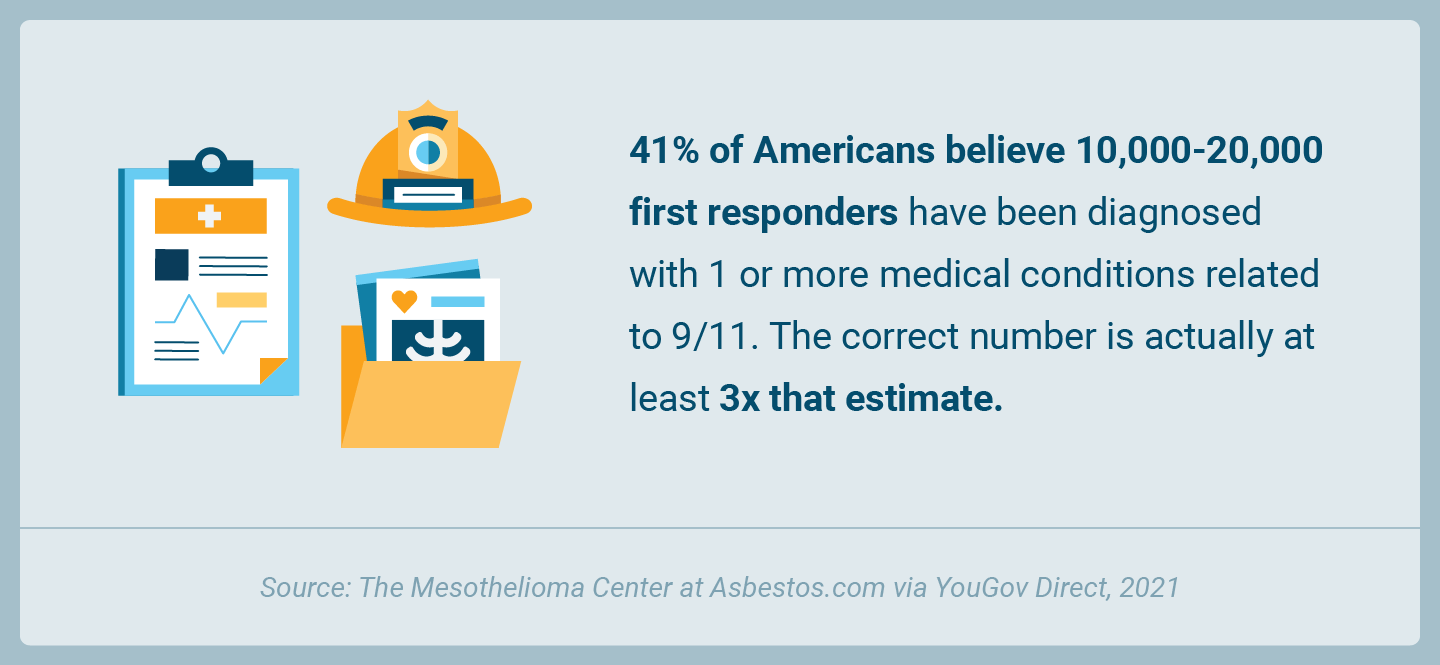
In the years since the attacks, news of ongoing and serious health issues among first responders has surfaced. Our recent survey revealed that 41% of respondents believe between 10,000 and 20,000 first responders have been diagnosed with at least one medical condition related to 9/11. The correct number is actually at least three times that estimate, at 63,500.
Physical and Mental Health Impacts From 9/11
Since the 9/11 attacks, more than 63,000 WTCHP registered members have developed one or more medical conditions stemming from their exposure. Respiratory and digestive issues are the most commonly reported. Chronic rhinosinusitis — or chronic inflamed sinuses — tops the list of reported illnesses with almost 33,000 current cases among first responders and survivors. Gastroesophageal reflux disease, or GERD, is the second-most commonly diagnosed illness with over 29,000 cases.
The traumatic events on 9/11 and the recovery efforts that followed had a major impact on the mental health of thousands of people involved. Some continue to struggle. Currently, more than 19,000 members of the WTCHP have been officially diagnosed with one or more mental health conditions, including 638 members who are now deceased.
The WTCHP covers a spectrum of mental health disorders, including post-traumatic stress disorder, depression, anxiety disorders, panic disorder and substance abuse. Numerous studies in the years since the attacks have shown the lingering effects of these issues for survivors and first responders.
- Almost 13% of police officers enrolled in the World Trade Center Health Registry were still experiencing PTSD symptoms 10 to 11 years after the attacks.
- Almost 50% of those officers were struggling with a combination of PTSD, depression and anxiety.
- Incidences of binge drinking and alcohol dependence were heightened for New York City residents diagnosed with PTSD after the attacks.
9/11 First Responders Face Greater Health Risks
There are currently 80,745 first responders registered with the WTCHP for health monitoring, treatment and support. The program primarily defines first responders as “workers or volunteers who provided rescue, recovery, debris cleanup, and related support services on or in the aftermath of the September 11, 2001, attacks.” Since the program’s creation in 2012, it has been tracking the health impacts on first responders and WTC survivors and those who lived and/or worked in the New York City disaster area. Other programs, including the WTC Health Registry, had tracked 9/11-related medical conditions prior to 2012.
WTCHP research from 2015 noted that emergency medical service workers and firefighters who were on the scene earliest at Ground Zero faced a higher risk of most 9/11-related health conditions. They were almost four times as likely to develop GERD and rhinosinusitis compared to WTCHP participants who never worked at the WTC site.
There is recent evidence indicating the arrival time and duration of time spent at Ground Zero impacted the rate of risk for each first responder, with those who arrived earlier and made repeat visits exposed to more toxic air than others. The study, published in the Journal of the American Medical Association in 2019, found that firefighters who arrived on the morning of 9/11, compared with those who arrived later, had a 44% greater risk of developing cardiovascular disease.
What Are 9/11 First Responders Dying From?
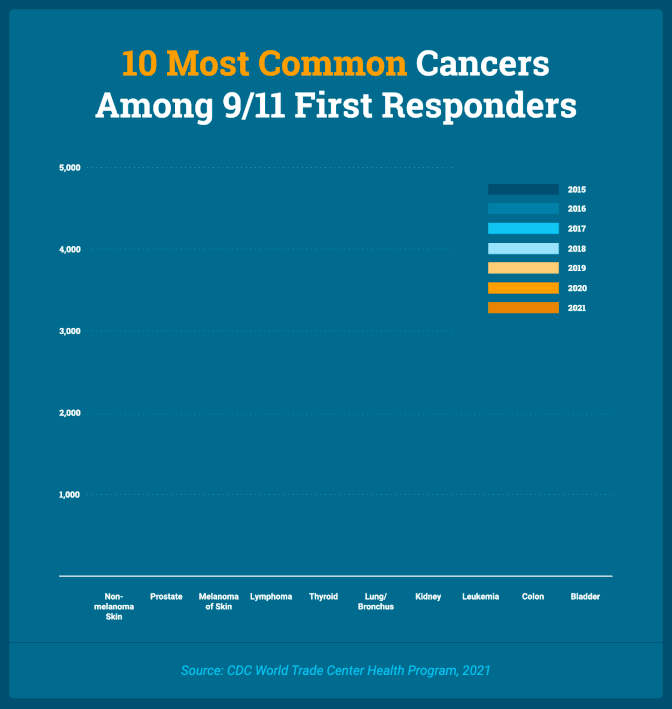
Respiratory diseases and cancer have caused the most deaths among first responders over the past 20 years. The toxic cloud of dangerous particles inhaled by so many first responders made their bodies more susceptible to these illnesses. To date, 1,469 WTCHP members have died from 9/11-related airway and digestive disorders, while 1,366 died from related cancers.
The WTCHP is tracking dozens of types of cancer that have impacted first responders. Non-melanoma skin cancer has had the highest rate of occurrence thus far, but some cancers such as mesothelioma take decades to develop. Because of that fact, cancer diagnoses and deaths among 9/11 first responders are expected to rise over the next decade.
It’s important to note that with so many first responders living with vulnerable health, COVID-19 became a new threat and has taken the lives of dozens of 9/11 heroes.
Timeline of Health Issues Since 9/11
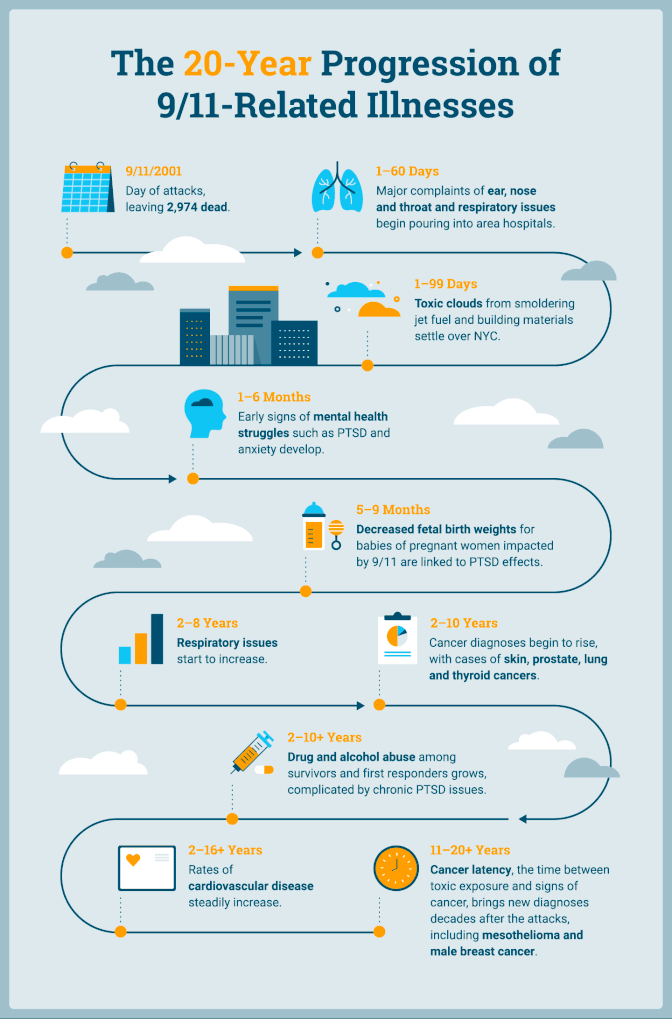
9/11/2001 – day of attacks: Death toll from 9/11 attacks
Between the attacks on the twin towers of the World Trade Center, the Pentagon and the crash site of United Airlines Flight 93 in Shankstown, Pennsylvania, 2,974 people died on Sept. 11, 2001.
1-99 days after the attacks: Toxic cloud
The fall of the World Trade Center towers created a giant toxic cloud. It was a blend of soot from fires burning off jet fuel and other chemicals, plus the dust of pulverized building materials such as glass, metal and asbestos, which had been used extensively as a flame retardant in the north tower.
On Sept. 13, an Environmental Protection Agency administrator mistakenly claimed there appeared to be “no significant levels of asbestos dust in the air in New York City,” creating a false sense of safety. Ground Zero smoldered until Dec. 19, releasing dangerous fumes the entire time.
7-60 days after the attacks: Immediate effects
Early complaints of ear, nose and throat irritations, as well as respiratory issues, were the most common initial complaints from first responders and survivors. Within one month of 9/11, almost 50% of residents surveyed from the areas closest to the World Trade Center admitted to having experienced nose, throat or eye irritation.
1-6 months after the attacks: Early signs of PTSD
With more than 400,000 people exposed to the trauma of the attacks, recovery efforts and the toxic environment, PTSD became a common diagnosis. One study of Manhattan residents revealed that almost 60% of participants had experienced at least one PTSD symptom within the first month following the attacks. The most common symptoms were insomnia and intrusive memories.
5-9 months after the attacks: The youngest survivors
Pregnant women exposed to the airborne contaminants and trauma of 9/11 were more likely to deliver babies with reduced birth weight and experience shorter gestational periods. This has proven to be consistent with birth outcomes after intensely stressful events such as other terrorist attacks and natural disasters.
2-8 years after the attacks: Respiratory issues continue to increase
Asthma rates steadily increased among those exposed to the toxic cloud around Ground Zero. Of residents who participated in the WTC Health Registry, 8% were newly diagnosed with asthma five to six years after 9/11. And rates of respiratory issues such as cough, shortness of breath and sinus problems were still on the rise five to seven years after 9/11.
2-10 years after the attacks: Cancer diagnoses begin
Leukemia, prostate and thyroid cancer rates increased among first responders. A Mount Sinai report indicates that 9/11 police officers and recovery workers face a 41% higher risk of leukemia and a 219% increased risk of thyroid cancer.
2-10+ years after the attacks: Substance abuse & mental health struggles
Many continued to struggle with PTSD, depression, anxiety and substance abuse. One study discovered that PTSD was statistically a factor in both drug-related and alcohol-related hospitalizations from 2003 to 2010 for residents directly impacted by 9/11.
2-16+ years after the attacks: Higher rates of cardiovascular disease
WTC toxic dust exposure has been shown to damage the heart and the blood vessels surrounding it. High levels of exposure to the carcinogenic fumes have been directly linked to heart disease-related mortality.
11-20+ years after the attacks: Cancer cells lying in wait
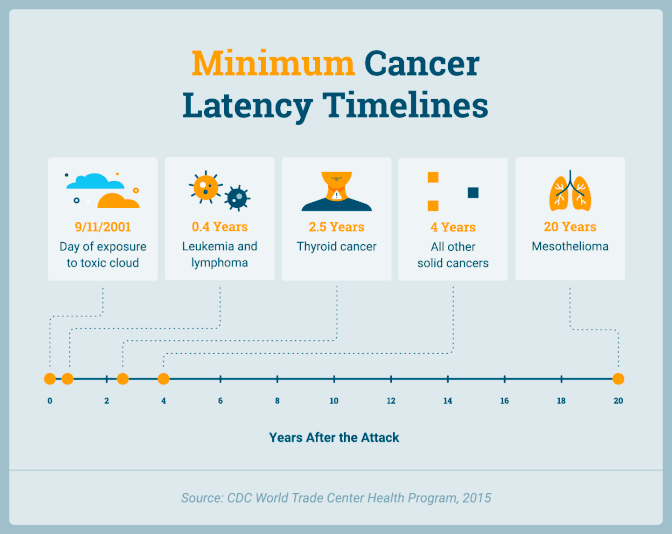
Some cancers take more time than others to incubate in the human body and reveal themselves. Longer latency times for cancers such as mesothelioma mean that cases have only just started to trickle in. For example, the first death from 9/11-related pleural mesothelioma occurred in 2006, with the second death coming only recently, in 2020.
Advocating for Support for 9/11’s Ongoing Victims
For all of the people living with compromised health over the past two decades as a result of 9/11, it has not been an easy road. Gaining access to quality health care, treatment options and medical reimbursements has required the fighting spirit of many 9/11 heroes and their advocates.
The September 11th Victim Compensation Fund, which was meant to compensate the families of those who were killed on 9/11 or those who suffered physical harm that day, initially operated from 2001 to 2004. But in the years that followed, as more and more first responders fell ill and died, advocates continued to fight for their right to compensation and health resources.
Our survey revealed 39% of Americans surveyed were shocked to discover it took 10 years for federal legislation creating the WTC Health Program to pass. Here is a brief rundown of the progress advocacy for 9/11 first responders and survivors has made in recent years:
- The James Zadroga 9/11 Health and Compensation Act was passed in 2010 and provided for financial compensation for first responders and survivors who are sick from 9/11 exposure by reopening the VCF. Named for a New York City police officer who died in 2006 from a 9/11-related respiratory illness, the act also created the WTCHP, which handles monitoring and treatment of approved health issues identified as 9/11-related. It serves survivors and first responders from all three attack sites.
- The 2010 act was to accept claims only through October 2016. Activists such as Jon Stewart helped lead the successful effort to get an extension of the plan to 2019. But first responders, survivors and activists were not satisfied with a brief extension, and lobbied for a more permanent solution.
- On July 29, 2019, the Never Forget the Heroes Act was signed into law. It authorized funding of the VCF through the year 2092 so that first responders and survivors will be able to get the support they need for their ongoing medical conditions and the unknown evolving health obstacles ahead.
For the past 20 years, thousands of 9/11 first responders and survivors have had to battle invisible, unpredictable and evolving damage to their health. In a shock to many Americans, the impact of exposure to the toxic environment surrounding Ground Zero continues to reveal itself through the rising death toll and new diagnoses of slowly developing cancers such as mesothelioma.
Methodology:
The survey featured in this post was conducted on YouGov Direct. One thousand U.S. adults ages 18 and older were surveyed July 21 and July 22 between 5:43 p.m. and 6:07 a.m. Eastern time. Data is weighted on age, gender, education level, political affiliation and ethnicity to be nationally representative of adults 18 and older in the United States. The margin of error is approximately 3.1% for the overall sample.




